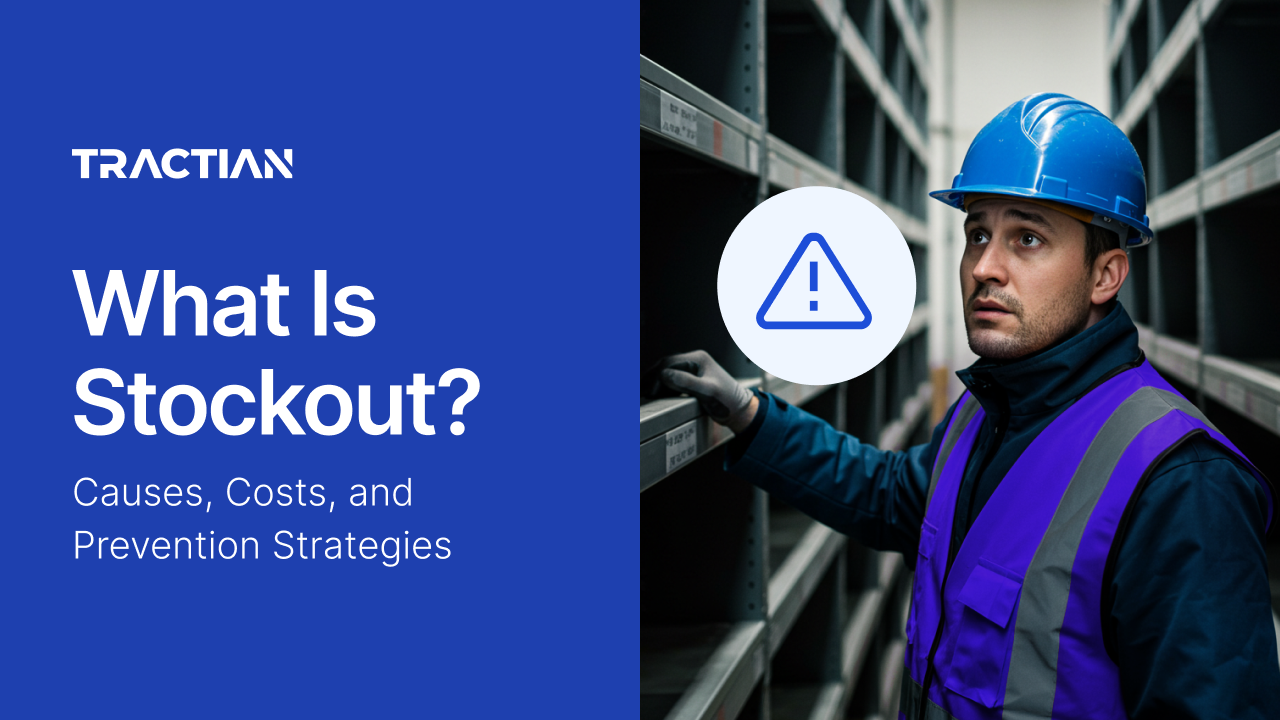When a critical bearing runs out just as your production line hits peak demand, you're not just facing an inventory shortage. You're facing the risk of a complete operational standstill when (not if) a failure occurs. At that point, you’ll be facing lost production time, unexpected sourcing expenses, and strained customer relationships. That’s a lot of trouble and loss for something easily avoidable.
During a stockout, you’re not simply running low on supplies. You also arrive at a moment when demand meets zero availability, which creates a cascade of problems that ripple through your entire operation. Even if the missing component has a relatively low purchase price, the downtime it causes can result in significant financial losses while you search for a replacement.
In this article, we'll break down what causes these costly disruptions, how to calculate their true financial impact, and most importantly, the proven strategies that keep your inventory flowing when operations depend on it most.
What Is Stockout and Why It Matters
When you walk into a store and see empty shelves, or when your production line suddenly stops because a critical component isn't available, you're witnessing a stockout firsthand. Simply put, a stockout is when inventory is completely depleted and customer demand cannot be fulfilled immediately.
However, the impact of a stockout extends far beyond simply running out of supplies. So, what is a stockout, really, in the fullest sense of the word? It's a cascading business disruption that ripples through every corner of your operation, affecting production schedules, customer relationships, and your bottom line.
Consider the following scenario: a manufacturing plant producing automotive parts experiences a stockout of a specific bearing required for their assembly line. The entire production stops. Workers stand idle, machines sit silent, and delivery commitments to major automotive manufacturers break. In effect, a single missing component represents a significantly higher cost than its purchase price. In reality, everything that follows its stockout is what it costs.
The difference between maintaining adequate stock inventory and experiencing a stock outage can determine whether your operation runs smoothly or grinds to a halt. Understanding what stockouts are and how they impact your business is a crucial first step toward building a more resilient operation.
Common Causes of Stockouts
Stockouts don't happen in a vacuum. They result from specific failures in planning, execution, or external circumstances that interrupt your supply flow. Let's examine what typically triggers these costly disruptions.
Inaccurate Demand Forecasting
Poor forecasting creates a dangerous gap between what you think you'll need and what you actually require. When your predictions miss the mark, you either order too little and face stockouts, or order too much, tying up capital in excess inventory.
Manufacturing operations face unique forecasting challenges that make stockout prevention particularly difficult. Seasonal demand shifts, unexpected large orders, or changes in production schedules can throw off even well-established patterns. A food processing plant might forecast steady demand for packaging materials, only to receive a surprise bulk order that depletes their stock in days instead of weeks.
Market trends and external events compound these challenges. The pandemic showed how quickly "normal" demand patterns can disappear, leaving companies with forecasts that became obsolete overnight.
Supply Chain Disruptions
External factors beyond your control can interrupt the steady flow of materials and components your operation depends on. These disruptions often strike without warning and can persist longer than anticipated.
Transportation issues create immediate bottlenecks. Shipping delays, port congestion, customs problems, or even a single truck breakdown can prevent critical supplies from reaching your facility on time. When you define stockout causes, transportation failures consistently rank among the top triggers.
Supplier problems add another layer of vulnerability. When your supplier faces production delays, quality issues, or financial difficulties, their problems become your stockout risks. A supplier bankruptcy can eliminate your entire source, forcing you to resort to emergency sourcing at premium costs.
Global events amplify these risks across entire supply networks. Natural disasters, political instability, trade disputes, and health crises can simultaneously disrupt multiple suppliers, making alternative sourcing difficult or impossible.
Lack of Real-Time Inventory Tracking
Without accurate, real-time visibility into your inventory levels, stockouts become inevitable surprises rather than preventable problems. Outdated inventory management systems create dangerous blind spots, leaving you flying blind when making critical supply decisions.
Manual processes introduce human error at every step. Handwritten logs, delayed data entry, and disconnected systems mean your inventory records lag behind reality. By the time you realize your stock is running out, it's often too late to reorder without disrupting operations.
Consider these common tracking failures:
- Inventory discrepancies: Physical counts don't match system records, creating false confidence in stock levels
- Delayed data entry: Inventory changes aren't recorded promptly, leaving decision-makers with stale information
- Siloed information: Different departments maintain separate inventory data, preventing coordinated planning
These tracking failures compound over time, making your entire inventory management system unreliable when you need it most.
Steps to Calculate Stockout Cost
Quantifying your stockout costs provides the data needed to justify investments in better inventory management. When you can demonstrate the financial impact in concrete terms, building compelling cases for operational improvements becomes much easier.
1. Measure Potential Lost Sales
Start with the immediate revenue impact of being unable to fulfill demand. Calculate the value of sales you couldn't complete because inventory wasn't available when customers needed it.
For manufacturing contexts, this includes the cost of production line stoppages. When a missing component shuts down your assembly line, multiply your hourly production value by the hours of downtime. Include both the direct product value and the fixed costs of idle equipment and labor.
2. Include Emergency Restocking Fees
Document the premium costs incurred when expediting replacement inventory. Rush orders and emergency shipping often lead to significantly higher costs compared to standard procurement and regular transportation methods.
Factor in overtime labor costs for teams working to minimize downtime, expedited quality control processes, and any additional handling fees. These emergency measures protect your operation, but at significantly higher expense than planned procurement.
3. Incorporate Long-Term Brand Impact
Estimate the cost of damaged customer relationships and reputation. Use customer lifetime value calculations to understand how stockouts affect future revenue streams.
Consider the competitive advantage you lose when customers experience your unreliability. In manufacturing, missed delivery commitments can result in contract penalties, lost preferred supplier status, or customers switching to more reliable competitors permanently.
4 Best Practices to Prevent Stockouts
Prevention costs far less than reaction, making proactive stockout prevention one of the highest-return investments in operational efficiency. Preventing stockouts begins with understanding your vulnerabilities and developing systems that address them systematically.

One: Improve Inventory Visibility
Real-time inventory tracking eliminates the blind spots that allow stockouts to develop unnoticed. Modern systems provide continuous visibility into stock levels, consumption rates, and reorder needs across all locations and supply chain stages.
Technology enables automatic alerts when inventory drops below predetermined thresholds, giving you time to reorder before stockouts occur. Integration between inventory systems and production planning ensures that material needs align with manufacturing schedules.
Two: Maintain Safety Stock Levels
Safety stock provides a critical buffer against demand variability and supply delays. Calculate appropriate levels based on lead times, demand fluctuations, and the cost of stockouts versus carrying costs.
The key lies in finding the balance between protection and efficiency. Too little safety stock leaves you vulnerable to disruptions, while too much ties up capital and storage space unnecessarily. Regular analysis of consumption patterns and supplier performance helps optimize these levels over time.
Three: Optimize Supplier Relationships
Building reliable supplier partnerships reduces stockout risks through better communication, performance visibility, and contingency planning. Establish clear communication protocols for changes in demand, delivery schedules, and potential disruptions.
Implement supplier performance metrics that track delivery reliability, quality consistency, and responsiveness to urgent requests. Develop backup suppliers for critical components to avoid single points of failure in your supply chain.
Four: Automate Reorder Points
Automation eliminates human error in inventory replenishment decisions. Set reorder points based on lead times, consumption rates, and safety stock requirements, and then let the system automatically trigger purchase orders when the thresholds are reached.
This approach ensures consistent replenishment without relying on manual monitoring or memory. Regular review and adjustment of reorder points keeps them aligned with changing demand patterns and supplier performance.
One example of a company that benefited directly from this CMMS approach is Castertech, who freed up resources by replacing paper-based tasks with Tractian CMMS. It's worth taking a look at how they achieved a significant decrease in labor hours dedicated to preventive and reactive maintenance, along with longer intervals between PMs, thereby optimizing the use of resources and man-hours.
How to Avoid Stockouts With Technology
Modern technology transforms inventory management from reactive guesswork into proactive control. Real-time monitoring capabilities provide continuous visibility into stock levels, consumption patterns, and reorder needs, eliminating the need for manual intervention.
Predictive analytics enhances demand forecasting by analyzing historical patterns, seasonal trends, and external factors that influence consumption. These insights help you anticipate needs more accurately and adjust inventory levels before shortages develop.
Integration between inventory and maintenance systems prevents stockouts of spare parts and maintenance supplies that directly impact equipment uptime. When your maintenance management system knows what parts are needed for upcoming work orders, it can automatically verify availability and trigger procurement for missing items.
Mobile access enables inventory management from anywhere in your facility. Technicians can update stock levels in real-time as they consume materials, ensuring accurate records without delays or data entry errors.
What does stockout mean for your operation? It means lost production, frustrated customers, and emergency costs that eat into profits. Understanding stockout and implementing the right systems prevents these costly disruptions.
How Tractian CMMS Can Prevent Costly Stockouts
Inventory inaccuracies often fuel stockouts that disrupt production lines and force expensive emergency procurement. When you don't know what spare parts you have on hand, or when existing inventory records don't match reality, equipment failures can catch you completely unprepared.
The real challenge isn't just tracking inventory. It's connecting inventory data with maintenance planning so you can anticipate needs before stockouts occur. Most systems operate in silos, leaving maintenance teams to discover missing parts only when they're needed for critical repairs.
Tractian CMMS eliminates these blind spots by providing centralized visibility into both maintenance schedules and parts inventory. When work orders are planned, the system automatically checks parts availability and flags potential stockout situations before they impact operations.
Your maintenance teams spend less time scrambling for parts and more time keeping equipment running. Automated reorder alerts ensure critical components are available when needed, while detailed consumption tracking helps optimize inventory levels over time.
The difference between reactive stockout management and proactive prevention comes down to having the right information at the right time. With complete inventory control integrated into your maintenance workflows, you can define out-of-stock situations as rare exceptions rather than routine disruptions.
Ready to eliminate stockout surprises from your maintenance operations?
Request a demo today and discover how Tractian CMMS transforms inventory management from a source of constant worry into a competitive advantage.
FAQ
What is a stockout vs. a backorder? A stockout means inventory is completely depleted and unavailable, while a backorder means you can still accept orders but will fulfill them when new inventory arrives.
How long do stockouts typically last? Stockout duration depends on supplier lead times and procurement urgency, ranging from a few days for local suppliers to several weeks or months for specialized components from distant suppliers.
Can stockouts be completely eliminated? While stockouts can't be entirely eliminated due to unpredictable demand and supply disruptions, proper planning and safety stock can significantly reduce their frequency and impact.
What industries are most affected by stockouts? Manufacturing, retail, and healthcare face the highest stockout risks due to their dependence on continuous supply flows and the immediate impact of missing inventory on operations.


